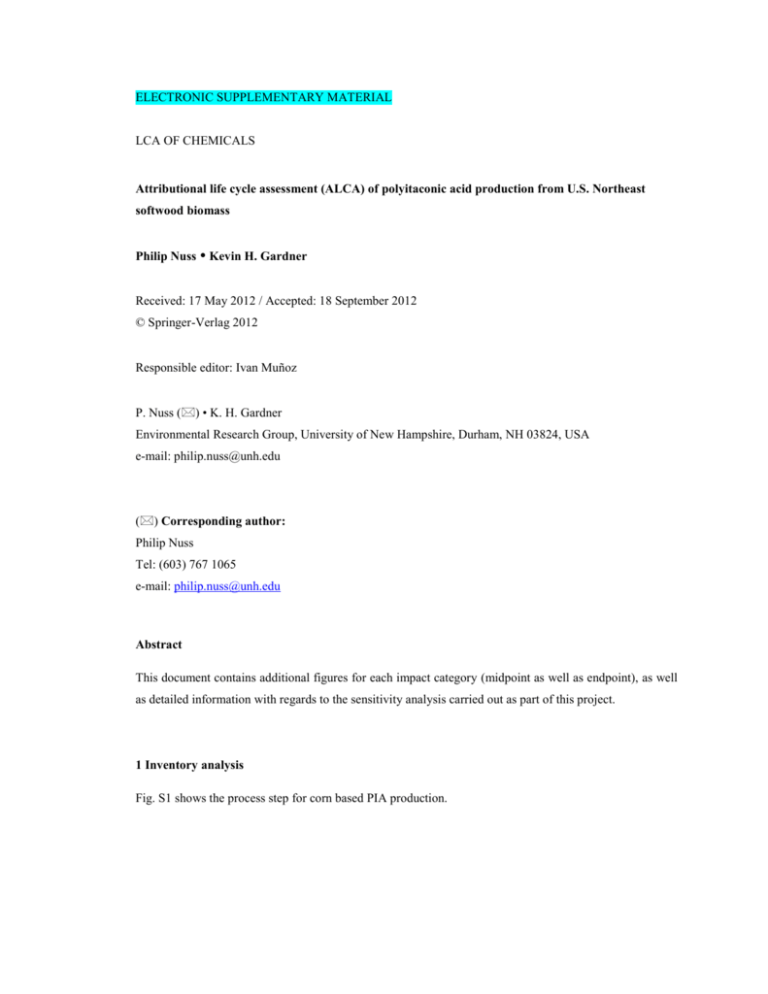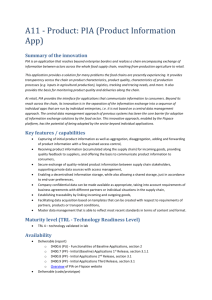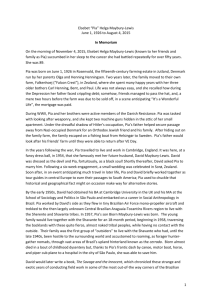Author template for journal articles
advertisement

ELECTRONIC SUPPLEMENTARY MATERIAL LCA OF CHEMICALS Attributional life cycle assessment (ALCA) of polyitaconic acid production from U.S. Northeast softwood biomass Philip Nuss • Kevin H. Gardner Received: 17 May 2012 / Accepted: 18 September 2012 © Springer-Verlag 2012 Responsible editor: Ivan Muñoz P. Nuss () • K. H. Gardner Environmental Research Group, University of New Hampshire, Durham, NH 03824, USA e-mail: philip.nuss@unh.edu () Corresponding author: Philip Nuss Tel: (603) 767 1065 e-mail: philip.nuss@unh.edu Abstract This document contains additional figures for each impact category (midpoint as well as endpoint), as well as detailed information with regards to the sensitivity analysis carried out as part of this project. 1 Inventory analysis Fig. S1 shows the process step for corn based PIA production. Fig. S1 Process flow chart for the production of corn-based PIA polymers. 2 Life cycle impact assessment 2.1 Midpoint Impacts The following figures show contributions of each life-cycle step to each midpoint impact category. Fig. S2 Global warming potential (GWP) of the PIA polymers (1 kg at the factory gate) from wood and corn feedstock compared to the production of an equivalent amount of PAA from fossil-feedstock. Fig. S3 Cumulative energy demand (CED – fossil/nuclear) for the three polymer production routes. Fig. S4 Cumulative energy demand (CED) for non-renewables and renewables comparing 1 kg polymer output from the different production routes. Even if the energy content of the non-renewable biomass is taken into account, CED is still lowest for the softwood-based PIA production route. Fig. S5 Acidification impacts associated with the production of 1 kg polymer at the factory gate. Fig. S6 Eutrophication impacts associated with the production of 1 kg polymer at the factory gate. Fig. S7 Water use associated with the production of 1 kg polymer at the factory gate. Fig. S8 Land occupation associated with the production of 1 kg of polymer at the factory gate. 2.2 Endpoint Impacts (ReCiPe) Finally, polymers produced from NE softwood are compared to corn feedstock and conventional fossilbased PAA production using the ReCiPe (H/A) endpoint method (see main manuscript) (Goedkoop et al. 2009). Fig. S9 shows the single impact score for the softwood based Itaconix process per unit process (i.e. feedstock growth/harvest, sugar extraction, fermentation, recovery, and polymerization). Please note that carbon temporarily sequestered in the PIA polymer has been excluded from the assessment. Fig. S9 Single impact score using ReCiPe for each unit process of the foreground system of softwood-based PIA production. The functional unit is 1 kg of PIA at the factory gate. As expected, polymerization with its high conversion efficiency leads to almost no environmental impact, while recovery and fermentation contribute significantly to climate change and fossil depletion. The process of feedstock (i.e. softwood) growth and harvest has the largest impact to land use as discussed earlier. Environmental impacts were calculated using the ReCiPe endpoint method (World H/A). It should be noted that calculation of a single score leads to higher uncertainty when compared to midpoint indicators. Results shown in this figure should therefore be used in connection with mid-point results (see previous sections). 7 3 Sensitivity analysis We perform a sensitivity analysis1 in order to see the influence of the most important assumptions on the results of the LCA. This includes: The influence of mass vs. economic allocation for outputs of the sugar extraction unit process; The influence of mass vs. economic allocation for mycelium by-produced during fermentation Stability of the results with regards to varying electricity mixes (i.e. NEPOOL vs. U.S. average vs. Hydropower) Varying inputs of activated carbon (AC) to the xylane extraction and itaconic acid (IA) recovery process 3.1 Mass vs. economic allocation The choice of mass vs. economic allocation for product outputs from the xylane extraction process (a multi-output process), during which fermentable carbohydrates, pulp-grade wood, and lignin are produced, plays an important role for the results of the LCA. Mass allocation accounts for the fact that hemicellulose for sugar extraction represents only a small fraction (by mass) of the softwood, while the remainder (excluding a small lignin fraction) is assumed to be sent as feedstock to a conventional pulp & paper plant after extraction took place. Mass allocation in this sense accounts for the stream integrated approach pursued by Itaconix in which it is assumed that the biorefinery is co-located (or in close proximity) to a pulping plant accepting the partially macerated softwood as feed. However, from an economic standpoint it may make sense to look at the economic value of each product output (i.e. the hemicellulose for sugar extraction, pulp-grade wood and lignin). According to current practices hemicellulose and lignin would be burned on-site the pulp & paper plant. Economic allocation should therefore be based on the economic heating value of each product output. Based on a heating value of 13.6 MJ/kg for hemicellulose and 25 MJ/kg for lignin (Amidon 2006), and a heating value of 15 MJ/kg and market price of $35 per tonne for pulp-grade wood (Durant 2011), the economic value of hemicellulose and lignin equals $32 per tonne and $59 per tonne, respectively. Market prices of extraction products [$/tonne] Source Allocation [%] based on mass Allocation [%] based on economic value 1 Please note that carbon temporarily sequestered in the PIA polymer has been excluded from results of the subsequent sensitivity analysis. 8 Fermentable sugars1 Pulp-grade wood 31.98 2 35.27 Lignin3 58.78 (Amidon 2006) (Durant 2011) (Amidon 2006) 7.20 6.53 91.99 92.12 0.81 1.35 Table S1 Average market prices as of January 2011 and corresponding allocation factors for the products of the Itaconix extraction process. 1Based on a heating value of 13.6 MJ/kg for hemicellulose. 2Based on a price for pulp-grade wood chips of $32/short ton and a heating value of 15 MJ/kg. 3Based on a heating value of 25 MJ/kg for lignin. As shown in Table S1, applying economic allocation does not result in a significant difference in allocation percentages. Similar to this, instead of mass allocation the use of economic allocation can be applied to the outputs of the fermentation process, i.e. itaconic acid and mycelium. Mycelium, being rich in protein, has the potential to replace conventional animal feed such as high-protein soybeans, meat & bone meal, or fish meal. We assume that the mycelia by-product would replace high-protein soybean animal feed. Market prices of fermentation products [$/tonne] Itaconic acid1 1625.00 Mycelia2 800.57 Source (Itaconix, LLC 2009) (USDA 2011) Allocation [%] based on mass Allocation [%] based on economic value 46.77 64.07 53.23 35.93 Table S2 Average market prices as of January 2011 and corresponding allocation factors for the products of the Itaconix fermentation process. 1Based on a price of $1.35-1.90/kg for itaconic acid (Itaconix, LLC 2009). 2Based on a price for high-protein soybean animal feed of $0.36/lb (USDA 2011) which is assumed to represent animal feed to be replaced. The market price of itaconic acid, ranging between $1.35-1.90/kg (Itaconix, LLC 2009), is higher than animal feed and therefore more of the environmentally relevant mass and energy flows are counted towards the PIA product (Table S2). A comparison of the impact of mass vs. economic allocation on all environmental impact categories of the softwood-based PIA polymer is shown in Fig. S10. Quantitative results of the allocation comparison are shown in Table S3. 9 Fig. S10 Sensitivity of the results of the softwood-based LCA to changes in allocation assumptions (i.e. mass vs. economic allocation for outputs of the sugar extraction and fermentation unit processes). The first bar shows results based solely on allocation by mass (see results shown in the previous sections for a detailed contribution analysis). In order to put results into perspective, the grey bar represents results of the LCA looking at conventional fossil-based PAA production. Mass stands for mass allocation, econ for allocation based on the economic value of the unit process outputs. Impact category Unit IPCC GWP 100a* CED (fossil/nuclear) kg CO2 eq mass/mass (Baseline) 1.321E+00 MJ eq Eutrophication H+ moles eq kg N eq Water use m3 Acidification econ/mass mass/econ econ/econ PAA 1.311E+00 1.471E+00 1.457E+00 2.738E+00 1.499E+01 1.474E+01 1.764E+01 1.730E+01 7.058E+01 3.781E-01 3.738E-01 4.388E-01 4.329E-01 4.525E-01 9.659E-03 9.654E-03 9.698E-03 9.691E-03 4.253E-04 7.506E-03 7.445E-03 9.967E-03 9.882E-03 4.784E-03 Land occupation m2a 8.412E+00 7.801E+00 1.084E+01 1.001E+01 2.435E-02 Table S3 Sensitivity of the results of the softwood-based LCA to changes in allocation assumptions (i.e. mass vs. economic allocation for outputs of the sugar extraction and fermentation unit processes). Mass/Mass: Allocation for products/byproducts of both unit processes is based on mass; Econ/Mass: Economic allocation is applied to outputs of the sugar extraction process, while mass allocation is applied to the outputs of fermentation; Mass/Econ: Mass allocation is applied to sugar extraction and economic allocation to fermentation; Econ/Econ: Economic allocation is applied to all products/byproducts. *Carbon sequestered in the PIA has been excluded. Results of the analysis indicate that applying economic allocation to the extraction process results only in a minimal decrease in environmental burdens. This decrease is most distinct for impacts related to land occupation as upstream environmental burdens from softwood growth and harvest are allocated more towards pulpwood and lignin product outputs if economic heating values are taken as basis for allocation. Allocating energy and material flows associated with outputs of the fermentation process by economic value leads to higher system-wide environmental burdens per kg of polymer produced 10 for all impact categories when compared to the initial analysis in which only mass allocation was applied. The increase is largest for impacts to acidification (0.38 (mass/mass) vs. 0.44 H+ moleseq (mass/econ)), water use (0.00751 (mass/mass) vs. 0.00997 m3 (mass/econ)), and land occupation (8.4 (mass/mass) vs. 10.8 m2a (mass/econ)). This is due to the fact that more of the upstream environmental burdens of sugar extraction and softwood harvest & growth are now allocated to the PIA polymer. Applying economic allocation to both multi-output processes (sugar extraction and fermentation) results in only a slight increase in environmental burdens to GWP (1.46 kg CO 2-eq), CED (17.3 MJ-eq), and eutrophication (0.00696 kg N-eq), while increases in impacts to acidification (0.043 H+ moles-eq), water use (0.0099 m3), and land occupation (10.1 m2a) are more pronounced. Under such a scenario impacts to acidification may be almost as high as acidification impacts from conventional fossil-based PAA production (0.452 H+ moles-eq). Eutrophication, water use, and land occupation are still higher for wood-based PIA production when compared to conventional PAA production. However, fossil CED and GWP associated with PIA production are still significantly lower when compared to its fossil-based counterpart. Relative contributions to each impact category of the softwood-based PIA lifecycle applying economic allocation to multi-output processes are shown in Fig. S11. Fig. S11 Relative contributions to each impact category of the softwood-based PIA lifecycle applying economic allocation (instead of mass allocation) to all multi-output processes (i.e. sugar extraction and fermentation). The choice of allocation also affects results of the corn-based PIA polymer. The use of market prices for allocation of impacts to products from corn-wet milling (i.e. glucose, corn meal & feed, and corn-oil) does not significantly change overall results (see Fig. S12). The reason is that the allocation percentages for corn-wet milling (Table S4) only change slightly with market prices. Market prices of corn wet milling products [$/tonne] Source Allocation [%] based Allocation [%] based on 11 Glucose (dextrose) from corn1 330.70 Corn meal & feed 252.03 Corn oil 838.42 (Durant 2011) (Moreau et al. 2010) (Moreau et al. 2010) on mass economic value 69.40 69.07 26.23 19.90 4.37 11.03 Table S4 Average market prices (January 2011) and corresponding allocation factors for the products of corn wet milling. 1Based on a dextrose price of $0.15/lb. On the other hand, applying economic allocation to the fermentation process leads to a 10-25% increase in environmental impacts to all impact categories of the corn-based PIA production route. Detailed results of this sensitivity analysis are shown in Fig. S12 and Table S5. Fig. S12 Sensitivity of the results of the corn-based LCA to changes in allocation assumptions (i.e. mass vs. economic allocation for outputs of the corn wet milling and fermentation unit processes). The first bar shows results based solely on allocation by mass (see results shown in the previous sections for a detailed contribution analysis). In order to put results into perspective, the grey bar represents results of the LCA looking at conventional fossil-based PAA production. Mass stands for mass allocation, econ for allocation based on the economic value of the unit process outputs. Impact category Unit IPCC GWP 100a* CED (fossil/nuclear) Acidification kg CO2 eq mass/mass (Baseline) 2.193E+00 MJ eq econ/mass mass/econ econ/econ PAA 2.189E+00 2.665E+00 2.659E+00 2.738E+00 2.480E+01 2.474E+01 3.107E+01 3.099E+01 7.058E+01 H+ moles eq 7.264E-01 7.245E-01 9.160E-01 9.135E-01 4.525E-01 Eutrophication kg N eq 1.642E-02 1.639E-02 1.896E-02 1.892E-02 4.253E-04 Water use m3 1.229E-02 1.226E-02 1.652E-02 1.648E-02 4.784E-03 Land occupation m2a 2.457E+00 2.454E+00 2.685E+00 2.681E+00 2.435E-02 12 Table S5 Sensitivity of the results of the corn-based LCA to changes in allocation assumptions (i.e. mass vs. economic allocation for outputs of the corn wet milling and fermentation unit processes). Mass/Mass: Allocation for products/byproducts of both unit processes is based on mass; Econ/Mass: Economic allocation is applied to outputs of the corn wet milling process, while mass allocation is applied to the outputs of fermentation; Mass/Econ: Mass allocation is applied to corn wet milling and economic allocation to fermentation; Econ/Econ: Economic allocation is applied to all products/byproducts. *Carbon sequestered in the polymer has been excluded. Relative contributions to each impact category of the softwood-based PIA lifecycle applying economic allocation to multi-output processes are shown in Fig. S13. Fig. S13 Relative contributions to each impact category of the corn-based PIA lifecycle applying economic allocation (instead of mass allocation) to all multi-output processes (i.e. corn wet milling (sugar extraction) and fermentation). In conclusion, applying economic allocation to the unit processes of sugar extraction and fermentation leads to slightly higher environmental burdens associated with the production of 1kg of PIA at the factory gate when compared to mass allocation. However, even if allocation is based to 100% on market prices (econ/econ), impacts to GWP, CED, and acidification associated with softwood-based PIA production are still lower than production of an equivalent amount of polymer via fossil-based or corn-based routes. Nevertheless, with regards to eutrophication, water use, and land occupation, fossil based PAA production still results in the lowest system-wide environmental impacts. A summary is shown in the following table. kg CO2 eq Softwoodbased PIA (econ/econ) 1.457E+00 Corn-based PIA (econ/econ) 2.659E+00 CED (fossil/nuclear) MJ eq 1.730E+01 3.099E+01 7.058E+01 Acidification H+ moles eq 4.329E-01 9.135E-01 4.525E-01 Eutrophication kg N eq 9.691E-03 1.892E-02 4.253E-04 Impact category Unit IPCC GWP 100a* Fossil-based PAA 2.738E+00 13 Water use m3 9.882E-03 1.648E-02 4.784E-03 Land occupation m2a 1.001E+01 2.681E+00 2.435E-02 Table S6 System-wide environmental burdens associated with the production of 1 kg PIA from softwood and corn applying economic allocation to all multi-output processes and in comparison to fossil-based PAA. The route with the lowest impact is shown in green color, while the route with the highest impact is shown in red. *Carbon sequestered in the PIA has been excluded. 3.2 Choice of energy mix The sensitivity of the choice of direct electricity inputs to processes of the biorefinery (i.e. sugar extraction, fermentation, recovery, and polymerization) is investigated by comparing results of the LCA study, using U.S. Northeast (NE) power grid inputs, to two different scenarios using either the U.S. average grid or 100% hydropower. These account for the fact that the biorefinery might be located in another part of the United States, or might use a renewable energy mix to power its processes in the near future2. Results of the analysis for softwood-based PIA are shown in the following figure. Quantitative results are shown in Table S7. Fig. S14 Results of the sensitivity analysis for softwood-based PIA investigating the choice of electricity inputs on the LCA results. Allocation is based completely on the mass. Results for fossil-based PAA (grey bars) are shown for comparison. Impact category Unit IPCC GWP 100a* kg CO2 eq US Northeast (Baseline) 1.321E+00 CED (fossil/nuclear) MJ eq Acidification H+ moles eq US average Hydropower PAA 1.482E+00 9.568E-01 2.738E+00 1.499E+01 1.784E+01 9.402E+00 7.058E+01 3.781E-01 4.182E-01 2.322E-01 4.525E-01 2 Itaconix indicated that the commercial plant may be located in close proximity to a hydropower dam which could supply electricity inputs to the biorefinery system. 14 Eutrophication kg N eq 9.659E-03 1.163E-02 9.605E-03 4.253E-04 Water use m3 7.506E-03 8.704E-03 7.242E-03 4.784E-03 Land occupation m2a 8.412E+00 8.419E+00 8.409E+00 2.435E-02 Table S7 Results of the sensitivity analysis for softwood-based PIA investigating the choice of electricity inputs on the LCA results. The functional unit is 1kg of polymer at the factory gate. Allocation is based on mass. Results for fossil-based PAA are shown for comparison. *Carbon sequestered in the PIA has been excluded. Results of the analysis show that the use of hydropower, having the lowest carbon intensity, reduces GWP to 0.96 kg CO2-eq and CED to 9.4 MJ-eq. Overall, the use of hydropower has the potential to reduce impacts to all categories (reductions in environmental burdens to eutrophication and land occupation are minimal), while using U.S. average power would lead to the highest impacts to all categories. However, this is least pronounced land occupation impacts as the majority of land takes place during feedstock growth which is relatively independent from energy use. Eutrophication impacts of the softwood-based LCA are mainly influenced by off-site treatment of effluent originating from biorefinery process which is relatively independent of electricity mix choices made. Fig. S15 and Table 8 show results of the sensitivity analysis for the corn-based life cycle. Fig. S15 Results of the sensitivity analysis for corn-based PIA investigating the choice of electricity inputs on the LCA results. The functional unit is 1kg of polymer at the factory gate. Allocation is based completely on the mass. Results for fossil-based PAA are shown for comparison. Impact category Unit US Northeast US average Hydropower PAA IPCC GWP 100a* kg CO2 eq 2.193E+00 2.605E+00 1.272E+00 2.738E+00 CED (fossil/nuclear) MJ eq 2.480E+01 3.210E+01 1.059E+01 7.058E+01 Acidification H+ moles eq 7.264E-01 8.290E-01 3.549E-01 4.525E-01 Eutrophication kg N eq 1.642E-02 2.147E-02 1.629E-02 4.253E-04 Water use m3 1.229E-02 1.536E-02 1.173E-02 4.784E-03 Land occupation m2a 2.457E+00 2.475E+00 2.449E+00 2.4350E-02 15 Table 8 Results of the sensitivity analysis for corn-based PIA investigating the choice of electricity inputs on the LCA results. The functional unit is 1kg of polymer at the factory gate. Allocation is based completely on the mass. Results for fossil-based PAA are shown for comparison. *Carbon sequestered in the polymer has been excluded. Results shown indicate a similar tendency with the highest impacts being found for the scenario using energy from the U.S. average power grid. For the impact category of GPW, the use of U.S. average power (2.61 kg CO2-eq) leads to an environmental impact only slightly lower than fossilbased PAA production (2.74 kg CO2-eq). In conclusion, the choice of a less carbon intensive electricity mix (e.g. from hydropower) has the potential to lead to significantly lower impacts in particular on GWP and CED for both softwood- and corn-based biorefineries. However, the impacts to eutrophication, water use, and land occupation are mainly a result of direct inputs and/or emissions to the biorefinery system including feedstock growth/harvest. As a result, these impacts are less influenced by choices made with regards to the electricity inputs. 3.3 Varying inputs of activated carbon Activated carbon (AC) used for the removal of chemical substances from the broth solution (sugar extraction and fermentation) was varied between 50% and 200% of the baseline value 3 (100%). Results for both softwood- and corn-based PIA are shown in the following figures and tables. Fig. S16 Sensitivity of varying amounts of activated carbon (AC) on the environmental impact results for softwood-based PIA. The functional unit is 1 kg of PIA at the factory gate. Impact category 3 Unit AC (50%) AC (100%) AC (200%) PAA The total quantity of AC used is not given due to confidentiality of the data. 16 Baseline IPCC GWP 100a* kg CO2 eq 1.094E+00 1.321E+00 1.776E+00 2.738E+00 CED (fossil/nuclear) MJ eq 1.450E+01 1.499E+01 1.596E+01 7.058E+01 Acidification H+ moles eq 3.647E-01 3.781E-01 4.050E-01 4.525E-01 Eutrophication kg N eq 9.639E-03 9.659E-03 9.698E-03 4.253E-04 Water use m3 7.341E-03 7.506E-03 7.838E-03 4.784E-03 Land occupation m2a 7.457E+00 8.412E+00 1.032E+01 2.435E-02 Table 9 Sensitivity of varying amounts of activated carbon (AC) on the environmental impact results for softwood-based PIA. The functional unit is 1 kg of PIA at the factory gate. *Carbon sequestered in the polymer has been excluded. Fig. S17 Sensitivity of varying amounts of activated carbon (AC) on the environmental impact results for corn-based PIA. The functional unit is 1 kg of PIA at the factory gate. Impact category Unit AC (2%) IPCC GWP 100a* kg CO2 eq 1.975E+00 AC (4%) Baseline 2.193E+00 CED (fossil/nuclear) MJ eq 2.433E+01 Acidification H+ moles eq Eutrophication Water use AC (8%) PAA 2.630E+00 2.738E+00 2.480E+01 2.573E+01 7.058E+01 7.135E-01 7.264E-01 7.522E-01 4.525E-01 kg N eq 1.640E-02 1.642E-02 1.646E-02 4.253E-04 m3 1.213E-02 1.229E-02 1.261E-02 4.784E-03 Land occupation m2a 1.539E+00 2.457E+00 4.294E+00 2.435E-02 Table 10 Sensitivity of varying amounts of activated carbon (AC) on the environmental impact results for corn-based PIA. The functional unit is 1 kg of PIA at the factory gate. *Carbon sequestered in the polymer has been excluded. Results show that the impact categories most significantly being influenced by varying amounts of AC used are GWP as well as land occupation. Optimizing the amounts of AC used during sugar extraction (only softwood-based process) and recovery (both softwood and corn-based biorefineries) therefore has the potential to lead to reduced impacts with regards to these impact categories. 17 References Amidon TE (2006) The biorefinery in New York: woody biomass into commercial ethanol. Pulp Pap-Canada 6(107):47-50 Durant Y (2011)Personal Communication Goedkoop MJ, Heijungs R, Huijbregts M, De Schryver A, Struijs J, Van Zelm R (2009) ReCiPe 2008, A life cycle impact assessment method which comprises harmonised category indicators at the midpoint and the endpoint level; First edition Report I: Characterisation Itaconix LLC (2009) The development of integrated production of polyitaconic acid from Northeast hardwood biomass. Grant Project Proposal, Itaconix, LLC, (Principal); Microbia, Inc.; University of Maine Moreau RA, Johnston DB, Hicks KB (2010) Corn Ethanol - Higher Value coproductsa and Corn Oil Recovery. Sustainable Biofuels and Coproducts Research Unit, ARS, USDA USDA (2011) Agricultural Marketing Service - Merket News and Transportation Data. <http://www.ams.usda.gov/AMSv1.0/ams.fetchTemplateData.do?startIndex=1&template =TemplateW&page=SearchFeedstuffsReports> (Jul. 6, 2011) 18






